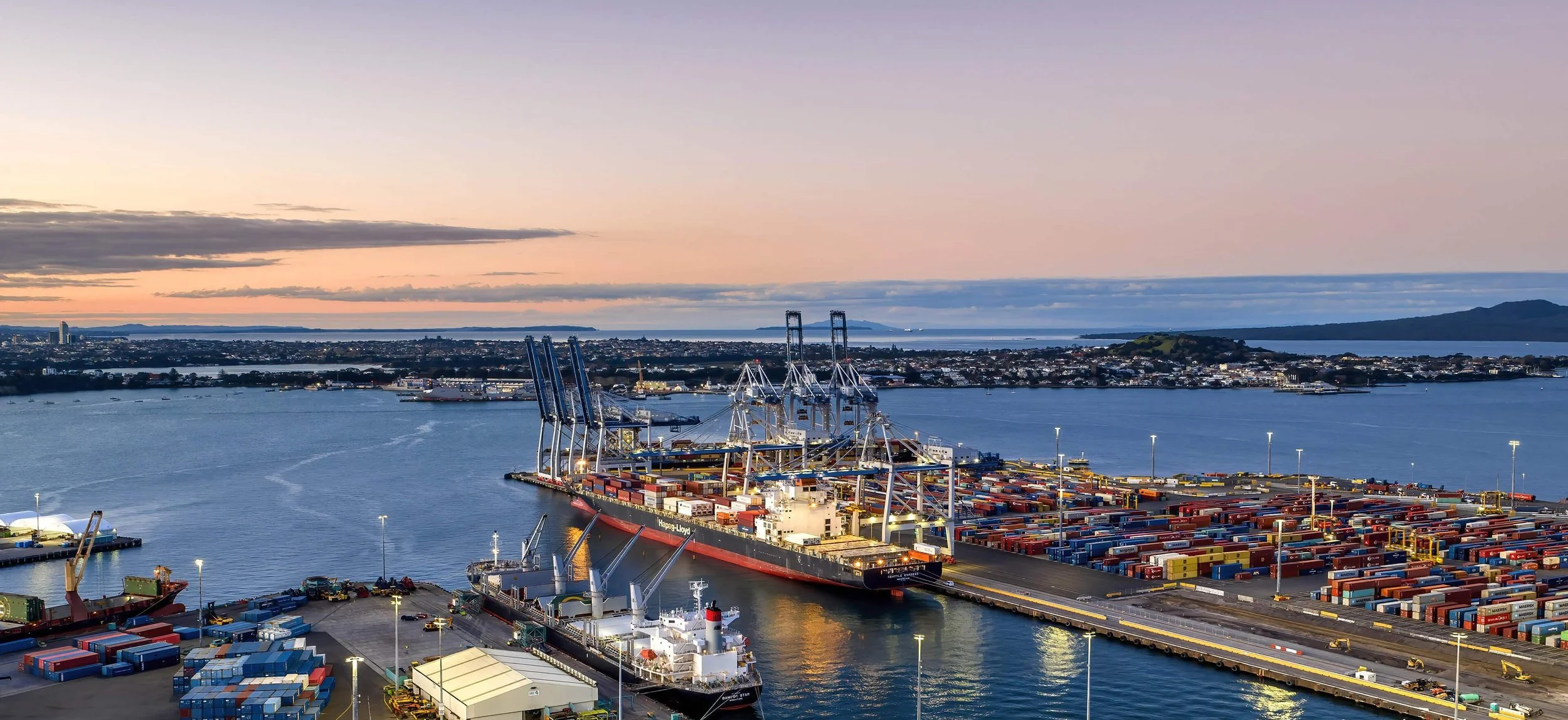Geopolitics, Trade Volatility, and Rural Land Investment
The Growing Impact of Trade Disruption
Geopolitics are playing an increasingly significant role in shaping New Zealand’s export landscape. The United States has expanded tariffs on a wide range of imports, Europe has tightened trade standards, and Asia-Pacific tensions remain elevated. These geopolitical shifts directly affect global supply chains, commodity flows and investment returns.
These trade wars, political tensions and unforeseen global events have disrupted international supply chains and impacted export flows. For the New Zealand primary sector, the stakes are high. The food and fibre sector comprises approximately 81% of New Zealand's goods exports, generating $59.9 billion in export revenue for the year ending June 30, 2025[1]. The Ministry of Primary Industries projects this will grow to $61.4 billion for the year ending June 30, 2026. When tariffs rise or trade routes are disrupted, producers feel the impact through input and output prices, increased competition with other exporters, reduced market access, and shifts in how markets value New Zealand as a trading partner.
Recent United States tariff increases highlight this dynamic. New Zealand Sauvignon Blanc exports, primarily destined for the United States, become relatively more expensive in that market, reducing returns for producers. For New Zealand beef, key competitors such as Australia face lower tariff to the United States and are therefore relatively cheaper than New Zealand options. For dairy, long-term contracts provide some buffer, but the overall environment is becoming more unpredictable. The Ministry of Foreign Affairs & Trade notes that, so far, disruptions have been manageable, but the risk profile is shifting and producers are, and will, feel these impacts.
More broadly, protectionist policies can reduce export revenues, create sudden competition in alternative markets, and increase volatility in commodity prices. Countries increasingly use these policies less for economic prosperity and more for statecraft - to enhance their national economy or serve other political interests. While New Zealand has historically benefited from strong ties with countries like China, evolving geopolitical tensions between major global powers underscore vulnerabilities in concentrated trade relationships. However, trade dynamics are complex, and New Zealand exports can sometimes benefit from trade wars. For example, if competing countries face tariffs, New Zealand dairy products to China become relatively more attractive.
Despite these challenges, New Zealand’s agricultural exports have shown remarkable resilience. This performance amid geopolitical volatility highlights the importance of food and fibre products and New Zealand’s role within global trade.
How Trade Volatility Affects Rural Land Values
The trade volatility driven by the current geopolitical environment impacts rural land prices through several channels:
Farm incomes: When geopolitical conditions reduce farm profitability, this can lower land values, which are fundamentally linked to the returns generated from the productive use of the land.
Financing and risk premiums: If global volatility makes earnings less predictable, investors apply higher risk premiums. Discount rates rise, softening capital values even if incomes hold steady.
Investor sentiment: Rural land is slow to reprice, but expectations matter. News of falling export margins can reduce market confidence, particularly for highly export-exposed producers. Short-term price volatility can occur as sentiment shifts.
The result is that returns from rural land become more variable in the short term. Periods of strong commodity prices can still deliver robust gains, but volatility in global trade adds downside risk, especially for land uses tightly tied to export markets.
Farmland's Defensive Characteristics in Volatile Markets
Yet it is crucial to look not only at absolute returns, but also at relative performance and compare rural land against equities, bonds, and other real assets. History shows that farmland has several qualities that can make it more attractive when geopolitics rattle financial markets:
Inflation hedge: Trade frictions often raise costs globally, fuelling inflation. Since 1910, farmland appreciation in the United States has demonstrated a 70% correlation with the Consumer Price Index, while the S&P 500 has shown a -10% correlation with inflation since 1928. Farmland's 70% correlation to the Consumer Price Index means it has historically moved in tandem with inflation[2]. When bonds deliver negative real returns and equities struggle in inflationary environments, farmland has provided effective inflation protection.
Stable income despite price volatility: Between 1992 and 2020, farmland (NCREIF Farmland Index) demonstrated a standard deviation of approximately 6.8-6.9%, less than half the 16.9% volatility of the S&P 500[3],[4]. This lower volatility primarily reflects the stability of agricultural income streams. While capital appreciation remained relatively constant over time, income returns fluctuated in line with CPI, providing farmland with two distinct and complementary return streams. However, land prices themselves can experience short-term fluctuations as market sentiment responds to geopolitical headlines. The key insight: agricultural income from quality farmland - particularly when leased - remains substantially more stable than returns from equities or the operational profits of farm businesses exposed to commodity price swings.
Portfolio diversification: Farmland has historically been negatively correlated with both US stocks (-0.06 correlation) and bonds (-0.39 correlation) over 30-year periods[5]. Since 2000, the correlation between farmland and the S&P 500 has been just 0.07, indicating neither a positive nor negative connection[6]. This lack of correlation means farmland returns are not driven by the same factors affecting financial markets, providing genuine portfolio diversification.
Superior risk-adjusted returns: When measured by the Sharpe ratio, which compares returns adjusted for volatility, farmland achieved 1.21 versus 0.59 for bonds between 1992 and 2021[7]. This indicates farmland delivered more than double the return per unit of risk compared to bonds.
Currency resilience: Global trade shocks often weaken the New Zealand dollar. For exporters, currency depreciation partly offsets tariffs and can even support farmgate returns. For landholders, values expressed in NZD may therefore be steadier than initially expected during trade disruptions.
Food security premium: In an era of geopolitical tension, farmland acquires strategic value. Governments and institutions alike increasingly view food production land as a scarce, resilient asset worth holding. In New Zealand, after a decade of policy-induced capital restrictions that kept farmland values flat despite rising farm productivity, current regulatory settings are renewing capital flows into the sector.
In contrast to rural land, equity markets can swing violently on tariff headlines, bonds can deliver negative real returns in inflationary conditions, and commercial property can face both repricing and refinancing risks. Recent economic conditions (rising interest rates, inflation) have increased the correlation between equities and bonds, weakening the diversification benefit of traditional 60:40 portfolios. Farmland’s historical low correlation with both makes it an increasingly valuable portfolio component.
The New Zealand Rural Land Company Advantage
New Zealand Rural Land Company's investment model - rural land with inflation-adjusted leases to high-performing operators - provides additional structural advantages in volatile trade environments:
Insulated income: This is the critical distinction. When geopolitical events create commodity price volatility, owner-operators face immediate income pressure as their revenues fluctuate with export prices. NZL's structure is different. Even if commodity prices fall and farm profits tighten due to trade disruptions, NZL continues to receive contracted rental payments from its tenants. The operational risk, including exposure to volatile commodity prices, sits with the farming tenant, not with NZL's investors. This separation of ownership and operation means that trade-driven farmgate volatility does not flow directly through to investor returns.
Inflation protection through lease indexation: NZL's inflation-linked lease contracts provide a powerful hedge during periods of trade-induced inflation. When trade frictions raise costs globally and inflation accelerates - precisely the environment created by tariffs and supply chain disruptions - NZL's rental income increases automatically through lease indexation. Higher inflation flows through as higher rental income. This mechanism means that the very trade frictions causing concern for owner-operators can benefit NZL investors through inflation-adjusted rental escalations.
Reduced income volatility: Because cashflows are contractually defined rather than tied to commodity prices, investor returns display greater stability than farm operational returns. NZL's lease structure captures this income stability while providing liquidity through NZX listing that direct farmland ownership cannot match.
Access without operational complexity: Investors gain exposure to New Zealand's world-class agricultural productivity and some of the world's most efficient farming systems, which have demonstrated improving productivity even during periods of policy headwinds, without assuming weather risk, animal health risk, operational management demands, or direct commodity price exposure.
In effect, geopolitical volatility that creates challenges for farm operators does not translate directly into volatility for NZL's investors. The lease structure acts as a buffer: operators absorb short-term commodity price shocks while investors receive stable, inflation-indexed cashflows. When farmland prices experience short-term sentiment-driven volatility due to geopolitical headlines, NZL's income stream remains anchored by long-term lease contracts rather than spot commodity markets.
Positioned for Resilience
Geopolitical shifts are impacting global trade and New Zealand's agriculture sector. Trade volatility creates both challenges and opportunities across the agricultural value chain. However, the defensive characteristics of farmland as an asset class - particularly when accessed through an inflation-linked lease structure- become more valuable during periods of uncertainty.
Farmland has historically provided lower volatility than equities, positive correlation with inflation when bonds struggle, and negative correlation with traditional financial assets. These characteristics suggest that farmland can serve as a genuine portfolio diversifier during periods when geopolitical events create synchronised stress across equity and bond markets.
For investors seeking exposure to New Zealand's agricultural productivity without the operational volatility that trade disruptions create at the farm level, NZL's model offers a differentiated approach. Contracted, inflation-indexed rental income provides cashflow stability even when commodity prices fluctuate, trade routes shift, or short-term land price sentiment responds to geopolitical headlines.
In an age where trade volatility, inflation uncertainty, and geopolitical tensions are increasingly prominent features of the investment landscape, the resilience of agricultural land - combined with the income stability of long-term lease structures - merits consideration as part of a diversified portfolio strategy.
Carla Muller
Principal Consultant, Perrin Ag.
[1] Ministry for Primary Industries, Situation and Outlook for Primary Industries (SOPI), June 2025
[2] https://acretrader.com/learn/agriculture-research/the-correlation-between-inflation-and-farmland-2025
[3] https://farmtogether.com/learn/blog/farmland-high-returns-low-volatility-critical-role
[4] https://farmtogether.com/learn/blog/farmland-vs-the-500
[5] https://farmtogether.com/learn/blog/farmland-an-uncorrelated-asset-class
[6] https://farmtogether.com/learn/blog/farmland-an-uncorrelated-asset-class
[7] https://caia.org/blog/2024/02/11/farmland-investing-vs-bonds
The opinions and views expressed in this article are the author's own and do not necessarily reflect the views and opinions of New Zealand Rural Land Company Limited or its Board of Directors.


